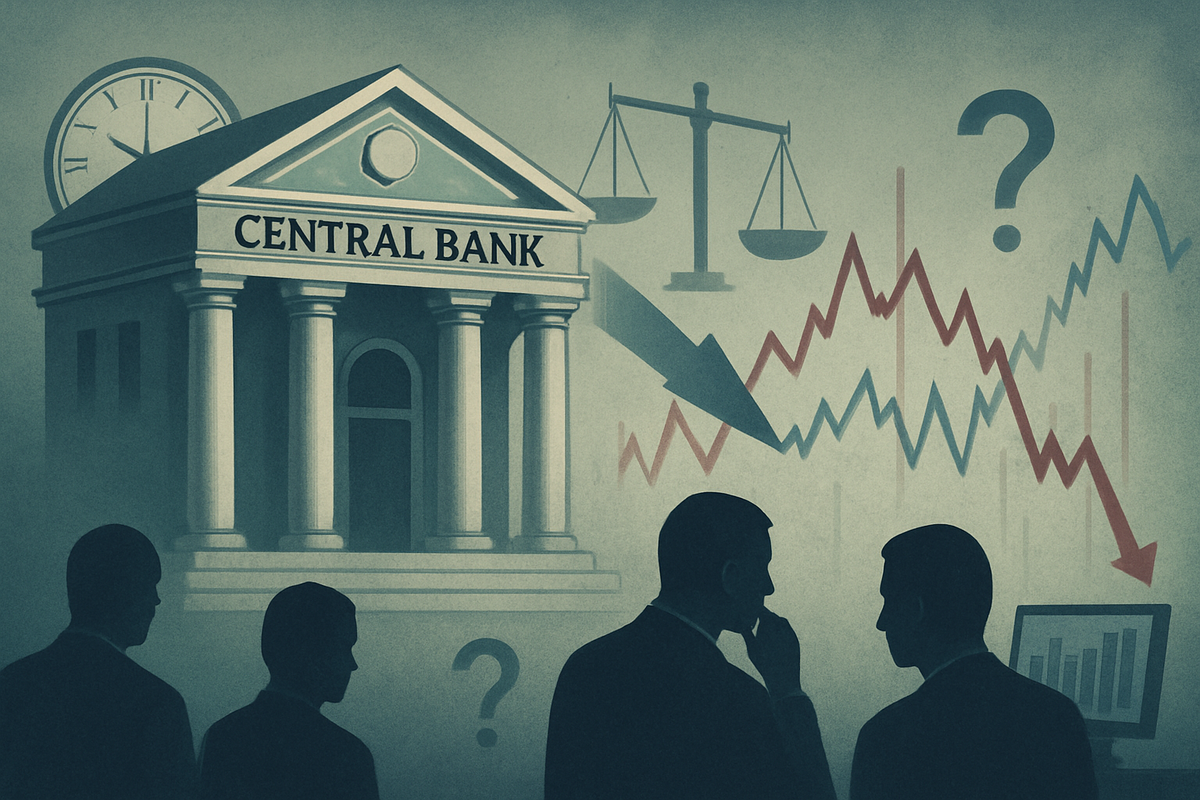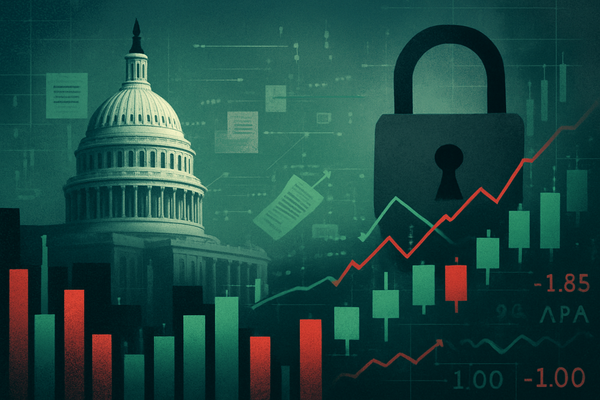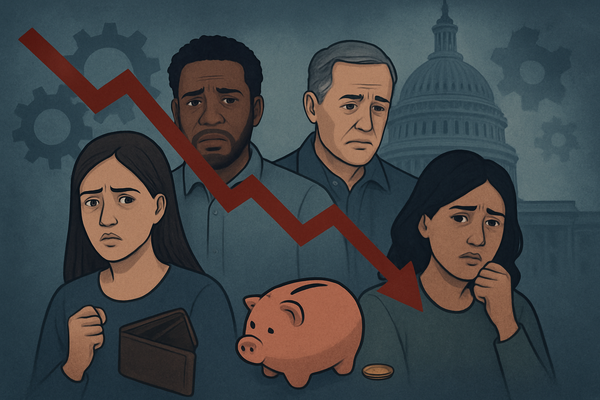Federal Reserve's Measured Pace Casts Shadow on Market's Rate Cut Hopes

The financial markets are grappling with a renewed sense of uncertainty as the Federal Reserve, despite implementing its second consecutive interest rate cut in October 2025, has signaled a significant hesitation regarding the pace of future monetary easing. Fed Chair Jerome Powell's cautious remarks, emphasizing that a further cut in December is "not a foregone conclusion" and that "policy is not on a preset course," have sent ripples through Wall Street, forcing investors to recalibrate their expectations for an aggressively dovish central bank. This measured approach, driven by a complex interplay of persistent inflation, data visibility issues, and a nuanced labor market, has introduced a fresh layer of apprehension, dampening the bullish sentiment that had propelled major indices to recent highs.
This unexpected deceleration in the Fed's easing narrative has had immediate and tangible effects across asset classes. Stock markets, particularly technology and growth sectors, experienced disappointment-driven sell-offs as the prospect of continuous lower rates diminished. Bond yields, contrary to expectations, climbed, while the U.S. Dollar Index (DXY) strengthened, reflecting a flight to safety and the allure of potentially "higher-for-longer rates" in the U.S. Gold prices, typically a beneficiary of a weaker dollar and lower rates, also saw a sharp decline. The central bank's reluctance to commit to a rapid easing cycle has injected volatility and a cautious undertone into investor confidence, challenging the prevailing narrative of an uninterrupted bull run.
Fed's Cautious Stance Unsettles Markets
The Federal Open Market Committee (FOMC) concluded its October 2025 meeting with a widely anticipated decision to lower the federal funds rate by 0.25 percentage points, setting the new target range between 3.75% and 4.00%. This marked the second consecutive cut, following a similar reduction in September, bringing rates to their lowest point since 2022. Concurrently, the Fed announced the conclusion of its quantitative tightening (QT) program, effective December 1, 2025, which had been gradually reducing its balance sheet. While these actions initially appeared dovish, the subsequent press conference by Chair Jerome Powell proved to be the pivotal moment that reshaped market expectations.
Powell's statements explicitly cautioned against assuming a continuous easing path, declaring that a December rate cut was "not a foregone conclusion" and reiterating that "policy is not on a preset course." This less-dovish-than-expected tone stemmed from several critical factors. A federal government shutdown in October had severely hampered the release of crucial economic data, including key labor market indicators, leaving the FOMC with an incomplete picture of the economic landscape. Furthermore, inflation remained "somewhat elevated," with the Consumer Price Index (CPI) for September 2025 rising to 3% year-over-year, surpassing the Fed's 2% target. Powell also highlighted an uptick in goods inflation, partly attributed to recent tariffs, adding another layer of complexity to the inflation outlook.
The Fed's decision-making process also revealed internal divisions, with "strongly differing views" among policymakers. While some, like Governor Stephen Miran, advocated for a more aggressive 0.50 percentage point cut, others, such as Jeffrey Schmid, preferred no change to rates at all, underscoring the delicate balancing act between supporting a softening labor market and combating persistent inflation. This fractured consensus further contributed to the uncertainty surrounding future policy moves. Initial market reactions were swift and pronounced: major U.S. indices, including the S&P 500 (NYSEARCA: SPY) and Nasdaq Composite (NASDAQ: QQQ), experienced "significant declines" and "disappointment-driven sell-offs" as investors unwound positions based on previous assumptions of continuous monetary easing. The Dow Jones Industrial Average (NYSEARCA: DIA) saw some gains, potentially signaling a rotation into less rate-sensitive sectors, but overall market sentiment shifted towards caution and increased volatility.
Navigating the Headwinds: Winners and Losers
The Federal Reserve's hesitant stance on future rate cuts creates a challenging environment, bifurcating potential outcomes for various public companies and sectors. Companies with heavy debt loads or those highly sensitive to borrowing costs are likely to face increased pressure, while others may find relative stability or even advantage in a "higher-for-longer" interest rate scenario.
On the losing side, highly leveraged companies and growth-oriented sectors, particularly technology and innovation stocks, often bear the brunt of delayed rate cuts. Companies such as Tesla (NASDAQ: TSLA) and other high-growth tech firms rely on readily available, cheap capital for expansion and innovation. Higher interest rates increase their cost of borrowing, making future projects more expensive and potentially compressing their profit margins. Similarly, the real estate sector, including homebuilders like D.R. Horton (NYSE: DHI) and real estate investment trusts (REITs) such as Simon Property Group (NYSE: SPG), could see dampened demand as mortgage rates remain elevated, impacting affordability for consumers and development costs for builders. Utilities and other capital-intensive industries might also struggle with increased financing costs for infrastructure projects.
Conversely, certain sectors and companies stand to benefit or remain resilient. Financial institutions, particularly large commercial banks like JPMorgan Chase (NYSE: JPM) and Bank of America (NYSE: BAC), often thrive in higher interest rate environments. Their net interest margins (NIM) — the difference between the interest they earn on loans and the interest they pay on deposits — tend to expand when rates are higher, boosting profitability. Companies with strong balance sheets, significant free cash flow, and less reliance on external financing will also be better positioned to weather the storm. Value stocks and dividend payers in stable sectors, such as consumer staples (e.g., Procter & Gamble (NYSE: PG)) or healthcare (e.g., Johnson & Johnson (NYSE: JNJ)), may attract investors seeking defensive plays and reliable returns amidst market uncertainty.
Furthermore, sectors that can pass on increased costs to consumers, or those with inelastic demand, might also fare better. Energy companies, for instance, often benefit from commodity price fluctuations that are less directly tied to interest rate movements. Overall, the market will likely favor companies demonstrating robust financial health, pricing power, and a clear path to profitability without excessive reliance on speculative growth funded by cheap debt. Investors are expected to scrutinize balance sheets and cash flow statements more closely, shifting focus from pure growth narratives to sustainable earnings and financial resilience.
Broader Implications and Historical Parallels
The Federal Reserve's current hesitation on aggressive rate cuts extends beyond immediate market reactions, resonating with broader industry trends and carrying significant implications for regulatory policy and economic stability. This cautious approach fits into a global narrative where central banks are grappling with the lingering effects of unprecedented monetary stimulus and new inflationary pressures, often exacerbated by geopolitical events and supply chain disruptions. The shift from a predictable easing cycle introduces an element of unpredictability that can ripple through international markets, affecting currency valuations, trade balances, and investment flows.
One significant ripple effect could be felt by emerging markets, which are particularly vulnerable to a strong U.S. dollar and higher U.S. interest rates. As the dollar strengthens, it makes dollar-denominated debt more expensive to service for foreign entities, potentially leading to capital outflows and increased financial instability in developing economies. For domestic competitors and partners, a prolonged period of higher rates could slow down M&A activity, as financing becomes more costly, and temper overall economic expansion. Industries reliant on global trade, such as manufacturing and logistics, could face headwinds if international economic growth is stifled by tighter financial conditions.
From a regulatory and policy perspective, the Fed's stance may prompt a re-evaluation of fiscal policy. If monetary policy is less accommodative, there might be increased pressure on governments to implement targeted fiscal measures to stimulate growth or support vulnerable sectors. Debates around government spending, deficit reduction, and industrial policy could intensify as policymakers seek alternative levers to manage the economy. The current environment also highlights the ongoing challenge of achieving the Fed's dual mandate of maximum employment and price stability in a complex, post-pandemic world marked by supply-side shocks and shifting labor market dynamics.
Historically, periods of central bank hesitation following initial easing cycles have often been characterized by increased market volatility and a re-pricing of assets. For example, similar moments during the early 2000s or even specific phases of the post-2008 recovery saw markets adjust to a more data-dependent and less predictable Fed. These historical precedents suggest that the current environment requires investors to be nimble and adaptable, recognizing that the path to normalization is rarely linear. The Fed's cautiousness underscores a commitment to avoiding a premature declaration of victory against inflation, even at the risk of some short-term market discomfort, prioritizing long-term price stability over immediate market appeasement.
The Road Ahead: Scenarios and Strategic Pivots
Looking ahead, the Federal Reserve's current stance sets the stage for several potential scenarios, each with distinct implications for the market and corporate strategies. In the short term, the market will remain acutely sensitive to upcoming economic data, particularly inflation reports and labor market statistics. Any signs of persistent inflation or unexpected economic weakness could either solidify the Fed's cautious approach or, conversely, force a more aggressive easing if a significant downturn materializes.
One plausible short-term scenario involves the Fed maintaining its current rate for an extended period, opting for a "wait-and-see" approach. This would mean fewer, if any, additional rate cuts in the immediate future, forcing businesses and consumers to adjust to sustained higher borrowing costs. In this environment, companies would need to prioritize operational efficiency, strengthen balance sheets, and focus on organic growth rather than debt-fueled expansion. Strategic pivots might include deleveraging, optimizing supply chains to mitigate inflationary pressures, and investing in technologies that enhance productivity. Market opportunities could emerge in sectors with strong pricing power and those less sensitive to interest rate fluctuations, while challenges would persist for highly leveraged or growth-dependent firms.
A longer-term possibility is a gradual resumption of rate cuts, but at a much slower pace than initially anticipated by the market. This would depend heavily on inflation sustainably trending towards the Fed's 2% target and a clear softening of the labor market without tipping into a severe recession. Such a scenario would offer some relief to businesses and consumers, slowly improving access to capital and potentially reigniting investment. Companies might then strategically pivot towards measured expansion, carefully assessing debt-financed opportunities. Market opportunities could broaden, but investors would likely maintain a more discerning eye, favoring companies with proven resilience and sustainable business models over speculative ventures.
Alternatively, a severe economic downturn or a significant and rapid disinflationary trend could force the Fed to reverse course and accelerate rate cuts. While less likely given the current "somewhat elevated" inflation, this "black swan" scenario would drastically alter the market landscape, potentially leading to a flight to safety and a re-evaluation of all asset classes. Companies would need robust contingency plans to navigate such a sharp economic contraction. Overall, adaptability and a strong focus on fundamental value will be paramount for investors and businesses alike in the coming months, as the Fed navigates a complex economic terrain with a clear bias towards data-dependency rather than pre-commitment.
Concluding Thoughts: A New Era of Prudence
The Federal Reserve's recent actions and communications mark a significant pivot, ushering in an era of heightened prudence and data-dependency in monetary policy. The key takeaway for financial markets is that the path to lower interest rates is neither predetermined nor assured, challenging the prevailing narrative of an easy and continuous easing cycle. This shift underscores the Fed's unwavering commitment to achieving its 2% inflation target, even if it means tolerating some short-term market volatility and a slower pace of economic stimulus. The central bank's cautious approach, driven by sticky inflation, incomplete data, and internal disagreements, highlights the complex tightrope walk required to balance price stability with economic growth.
Moving forward, the market will undoubtedly operate under a cloud of increased uncertainty regarding monetary policy. Investors should assess the market not through the lens of guaranteed rate cuts, but rather through the prism of a Federal Reserve that is highly reactive to incoming economic data. This implies that economic reports on inflation, employment, and GDP will carry even greater weight in shaping market sentiment and asset valuations. Companies with strong balance sheets, robust free cash flow, and less reliance on external financing are likely to outperform, while highly leveraged firms and speculative growth stocks may face continued headwinds.
Ultimately, the lasting impact of this period of Fed hesitation will be a recalibration of investor expectations and a renewed emphasis on fundamental analysis. The era of "easy money" driving market exuberance appears to be receding, replaced by a more disciplined environment where corporate earnings, financial health, and sustainable growth drivers will be paramount. Investors should watch closely for consistent trends in inflation data, the health of the labor market, and any further nuanced communications from Fed officials in the coming months. Adaptability, diversification, and a long-term perspective will be crucial for navigating a financial landscape where the central bank's hand is guided more by economic realities than by market desires.
This content is intended for informational purposes only and is not financial advice



